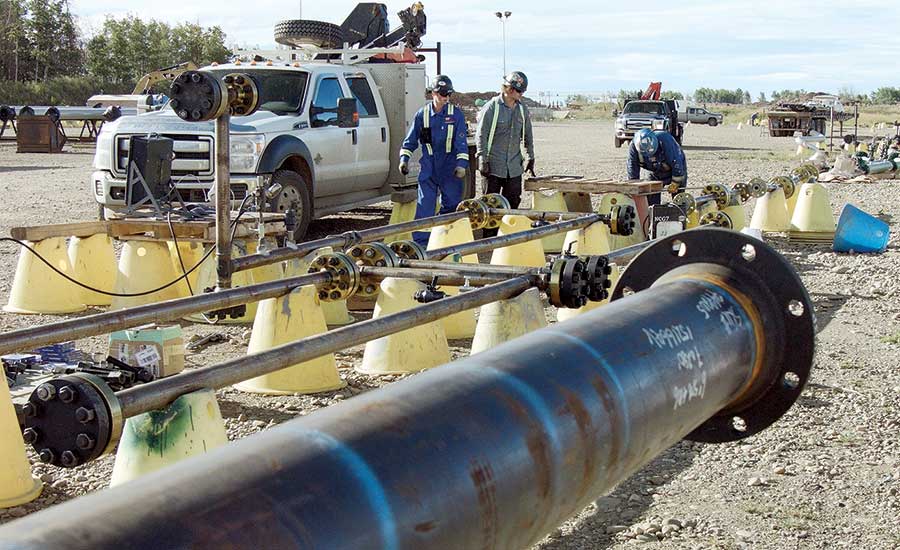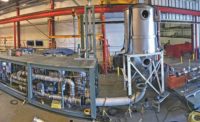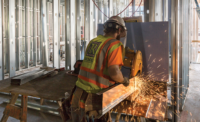It might seem like a geographic anomaly for a South Florida-based firm to be named ENR Midwest’s Specialty Contractor of the Year, but there’s little doubt utility construction specialist MasTec of Coral Gables is playing a pivotal role in both the expansion and diversification of the region’s energy infrastructure.
The firm’s lofty market role is easily understandable given that the 23,000-person organization is one of North America’s top providers of engineering and construction services for electric transmission and distribution systems, oil and natural gas pipelines and telecommunications networks.
Yet the company stands apart in the Midwest because few other regions in the country offer a more diverse mix of opportunities for MasTec’s resources and expertise—from national and regional supply line projects, to the wide open rural spaces where solar, wind and other renewable energy generating facilities are augmenting conventional power sources.
Small wonder then that projects in ENR Midwest’s coverage area accounted for nearly one-quarter of MasTec’s 2016 corporate revenue of $5.214 billion. Much of that work is associated with numerous multi-state pipeline projects being implemented across the region to accommodate increasing production of shale oil and gas from the Northeast and North Dakota.
MasTec handled a major section of Dallas-based Energy Transfer Partners’ recently completed $3.78-billion, 1,172-mile Dakota Access Pipeline between North Dakota and Illinois. Construction recently began on another ETP project—the $4.2-billion, 713-mile Rover natural gas pipeline, which will connect processing plants in West Virginia, eastern Ohio and western Pennsylvania with existing pipeline interconnections in Ohio and Michigan.
MasTec is also heavily involved with expansion and densification of the Midwest’s wireless infrastructure, including towers and cell connections for fiber optic networks.
MasTec’s selection as firm of the year in early September coincided with the arrival of Hurricane Irma’s 120-mph winds, which disrupted electric and communications networks across the state. As this issue went to press, MasTec’s managers were understandably focused on coordinating the work of several hundred of its utility repair personnel, who had been dispatched from other states to aid the recovery effort.
MasTec’s high industry profile and notable accomplishments reflect a major transformation of a company that traces its roots back more than 80 years, to a pair of Miami-area utility contractors that focused mainly on telephone projects after their merger in 1968.
That focus changed in 2007, when Jose Mas succeeded his father, Jorge, as the company’s CEO. The younger Mas initiated a concerted strategy of organic growth synchronized with key acquisitions of niche energy infrastructure contractors. By 2012, MasTec had developed into today’s diversified, multibillion dollar enterprise that is also among the nation’s largest Hispanic-owned businesses.
MasTec’s strategy ideally positioned the firm for the current boom in domestic shale oil and gas production, which continues to expand despite the current lull in worldwide oil prices. The U.S. Energy Information Agency (EIA) predicted that August 2017 shale oil production would rise to nearly 5.6 million barrels per day, a daily increase of 113,000 barrels from July.
Speaking before a recent Morgan Stanley investment conference, MasTec CFO George Pita explained that carrying out the short-duration, high-intensity “moving assembly line process” of pipeline projects requires contractors with specific skill sets, as well as a large, experienced workforce.
“There are only a handful of firms with our kind of capacity.”
– George Pita, CFO, MasTec
“There are only a handful of firms with our kind of capacity” to do these projects, Pita says, which is why customers in this sector prefer to work with proven providers rather than risk a billion-dollar job on a contractor with less experience.
The current level of domestic oil and gas activity was the biggest contributor to MasTec’s record second quarter 2017 financial performance of $1.89 billion, more than 50% higher than during the same period in 2016.
Pita noted that with shale oil becoming a permanent source of production, a multitude of projects should arise over the next three years. “The market has a lot of staying power,” he says.
Even with the uptick in oil and gas production, MasTec enjoys a strong position in the development, expansion and maintenance of renewable energy facilities. The company’s 2008 acquisition of Fargo, N.D.-based wind energy contractor Wanzek Construction provided MasTec with immediate design-build-maintain capabilities that have since been utilized on projects such as the 88-turbine, 200-MW Eclipse wind farm in Iowa, owned by Mid-America Energy, and Edison Mission Group’s 50-MW Jeffers wind farm in Minnesota.
And despite forecasts of a diminished urgency to develop renewable energy projects, the market is hardly idle, at least for the short term. The U.S. Department of Energy’s Annual Energy Outlook 2017 projected approximately 70 gigawatts of new wind and solar capacity from 2017 to 2021. Earlier this year, the EIA reported that renewable energy accounted for nearly two-thirds of new power sources on the U.S. electric grid in 2016, with the Midwest the leading region for wind production.
The agency also forecasts a 9% increase in Midwest renewable output during the three-year period ending in 2018.
Even with its current position as a leader in energy projects, MasTec continues to invest heavily in expanding its capabilities and improving operational efficiencies. In a statement, Jose Mas said the recent acquisition of an oil and gas specialty pipeline equipment leasing company “gives MasTec a competitive advantage” during the current multiyear cycle of activity that is expected to continue at record levels.
MasTec also acquired an undisclosed Texas-based provider of heavy civil, water, sewer and drainage systems infrastructure services. Mas said the move “will provide an exciting platform to benefit from increasing demand trends in this market.”






Post a comment to this article
Report Abusive Comment